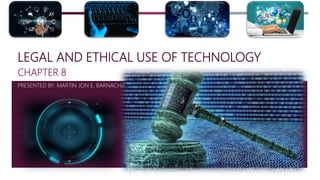
Educational Technology Chapter 8
- 1. LEGAL AND ETHICAL USE OF TECHNOLOGY CHAPTER 8 PRESENTED BY: MARTIN JON E. BARNACHIA
- 2. Technology and software issues are elaborated for you to be aware and be guided in doing the right thing and avoiding the unacceptable acts that may lead you to committing mistakes or possible software and technology crimes that’s against the law
- 3. ETHICAL USE OF SCHOOL TECHNOLOGY When we are young, our parents used to teach us the right behavior and etiquette. Even in schools and classes, there are certain behaviors and ethics we need to observe to achieve a healthy relationships with teachers and classmates.
- 4. ETHICS FOR COMPUTER USERS 1. Use the computer to help people and not to do harm. 2. Use your own or assigned computer unit and not to interfere with others’ work. 3. Us the computer using your own files and not to use others’ files. 4. Us the computer to share information and not to steal others’ information. 5. Use the computer to spread truthful information and not to do character assassination. 6. Use software that are original and legal and not pirated. 7. Use others’ computer resources with permission and not to duplicate it without authorization. 8. Use your own work and not the work of others. 9. Use the computer that shows respect and consideration for other people and not to do cyberbullying. 10. Create programs or software having in mind its social impact and not for self-interest.
- 5. ETHICAL ISSUES IN TECHNOLOGY AND SOFTWARE Unauthorized Access and Use of Hardware, Software, Network, and Computer Files If somebody would use anybody’s computer and files without permission from the owner, that is called unauthorized access. A person is called a cracker or a hacker if he/she tries to access a computer or network illegally to access data and commit malicious acts like identity theft. Hacker originally means a computer enthusiast who does well in computer that benefits other people. However, the term hacker now has an adverse connotation which refers to a person who breaks into the computer system to steal or corrupt the data in it.
- 6. TIPS IN CREATING A PASSWORD Use at least 8 characters. Use a combination of upper and lower case letters, words, numbers and special characters. Use joined words together. Add one or more numbers at the beginning, middle, or end of a word. Use words from other languages. Use a password that can be remembered easily. Select a password that can be entered easily even without looking at the keyboard. Do not leave written copies of your passwords anywhere. Do not share your password to anyone.
- 7. HARDWARE THEFT AND VANDALISM Computer Theft – stealing of hardware and its devices Computer Vandalism – act of damaging or breaking the hardware, cutting the cables and wires, smashing the computer and its devices, and deleting of software or computer files.
- 8. SOFTWARE THEFT Software piracy is a form of software theft. This happens when a person copies illegally copyrighted software for personal or business use.
- 9. EULA (END-USER LICENSE AGREEMENT) Single-user license agreement – the common type of license included in software packages purchased by an individual. Some of the conditions are: Users may install the software on only one computer. Users are prohibited to install the software on a network (school computer lab network) Users may make one copy for backup purposes. Users are prohibited to give copies to friends and colleagues.
- 10. Going against the agreement is a violation of copyright law, thus, committing a federal crime. In US, penalties reach up to $250,000 and up to five years in jail. In the Philippines, penalties reach up to Php1,500,000 and up to 6-9 years imprisonment.
- 13. INFORMATION THEFT A computer crime when one deliberately steals information for purposes of studying how to compete with other organizations or company. Encryption is the process of converting readable data to unreadable one. An encryption key is needed to enable the person to convert it back in readable form.
- 14. MALICIOUS ACT IN SOFTWARE Spam – unsolicited junk email sent indiscriminately in bulk, often for commercial purposes. Much of it is sent by botnets, networks of virus-infected computers, complicating the process of tracking down the spammers. According to various estimates, about 80% of all email in the world may be spam.
- 15. Phishing - a term used to describe a malicious individual or group of individuals who scam users. They do so by sending e-mails or creating web pages that are designed to collect an individual's online bank, credit card, or other login information. Also called as carding or spoofing.
- 16. Malware - short for “malicious software” - computer programs designed to infiltrate and damage computers without the users consent. “Malware” is the general term covering all the different types of threats to your computer safety such as viruses, spyware, worms, trojans, rootkits and so on.
- 17. Adware - frequently used to describe a form of malware (malicious software) which presents unwanted advertisements to the user of a computer. The advertisements produced by adware are sometimes in the form of a pop-up or sometimes in an "unclosable window".